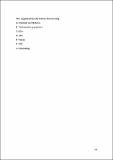Por favor, use este identificador para citar o enlazar a este item:
http://hdl.handle.net/10261/332574COMPARTIR / EXPORTAR:
 SHARE SHARE
 CORE
BASE CORE
BASE
|
|
| Visualizar otros formatos: MARC | Dublin Core | RDF | ORE | MODS | METS | DIDL | DATACITE | |

| Título: | Porous Carbon Materials Based on Blue Shark Waste for Application in High-Performance Energy Storage Devices |
Autor: | Brandão, Ana T. S. C.; State, Sabrina; Costa, Renata; Enache, Laura-Bianca; Potorac, Pavel; Vázquez, José Antonio CSIC ORCID; Valcárcel Barros, Jesús CSIC ORCID; Silva, A. Fernando; Enachescu, Marius; Pereira, Carlos M. | Palabras clave: | Marine biomass Chondroitin sulfate Gelatine Bio-carbon Carbonization process Deep eutectic solvents Specific capacitance Ball-milling |
Fecha de publicación: | 27-jul-2023 | Editor: | Multidisciplinary Digital Publishing Institute | Citación: | Applied Sciences 13(15): 8676 (2023) | Resumen: | The scientific community’s interest in developing sustainable carbon materials from biomass waste is increasing steadily, responding to the need to reduce dependence on fossil fuels. Every day, different biomass sources are suggested for obtaining porous carbon materials with characteristics for application in different areas. Porous carbon materials with a high specific surface area are a subject of interest for application in energy storage devices. This work reports the use of blue shark chondroitin sulfate and gelatine as precursors for developing porous carbon materials for energy storage devices. Commercial chondroitin sulfate was used for comparison. The porous carbons obtained in this study underwent various characterization techniques to assess their properties. A BET surface area analyzer measured the specific surface area and pore size. Additionally, scanning electron microscopy (SEM) coupled with energy dispersive X-ray analysis (EDX), a high resolution-scanning transmission electron microscope (HR-STEM), Raman spectroscopy, attenuated total reflectance Fourier transform infrared (ATR-FTIR) spectroscopy, X-ray diffraction (XRD), and X-ray photoelectron spectroscopy (XPS) were employed to examine the morphology, composition, and structure of the carbons. A modified glassy carbon (GC) electrode was used as the working electrode for the electrochemical characterization. Cyclic voltammetry and galvanostatic charge/discharge techniques were employed with ethaline, an environmentally friendly and sustainable electrolyte based on choline chloride, to assess the electrochemical performance. Furthermore, the most promising samples were subjected to ball-milling to investigate the impact of this process on surface area and capacitance. Blue shark chondroitin sulfate-based carbon presented a specific surface area of 135.2 m2 g−1, compared to 76.11 m2 g−1 of commercial chondroitin sulfate, both carbonized for 1 h at 1000 °C. Blue shark gelatine presented a specific surface area of 30.32 m2 g−1. The associated specific capacitance of these three samples is 40 F g−1, 25 F g−1, and 7 F g−1. Ball-milling on these samples increased the specific surface area and capacitance of the three studied samples with different optimal milling times. This study presents the novel utilization of carbon materials derived from blue shark (with and without ball-milling) through a one-step carbonization process. These carbon materials were combined with an environmentally friendly DES electrolyte. The aim was to explore their potential application in energy storage devices, representing the first instance of employing blue shark-based carbon materials in this manner. | Descripción: | 26 pages, 16 figures, 5 tables.-- This article is an open access article distributed under the terms and conditions of the Creative Commons Attribution (CC BY) license | Versión del editor: | https://doi.org/10.3390/app13158676 | URI: | http://hdl.handle.net/10261/332574 | DOI: | 10.3390/app13158676 | E-ISSN: | 2076-3417 |
| Aparece en las colecciones: | (IIM) Artículos |
Ficheros en este ítem:
| Fichero | Descripción | Tamaño | Formato | |
|---|---|---|---|---|
| Porous_Carbon_Materials_Brandao.pdf | 7,82 MB | Adobe PDF |  Visualizar/Abrir | |
| applsci-2475131-supplementary.pdf | Sup. material | 492,39 kB | Adobe PDF |  Visualizar/Abrir |
CORE Recommender
Page view(s)
39
checked on 18-may-2024
Download(s)
35
checked on 18-may-2024
Google ScholarTM
Check
Altmetric
Altmetric
Este item está licenciado bajo una Licencia Creative Commons

